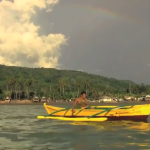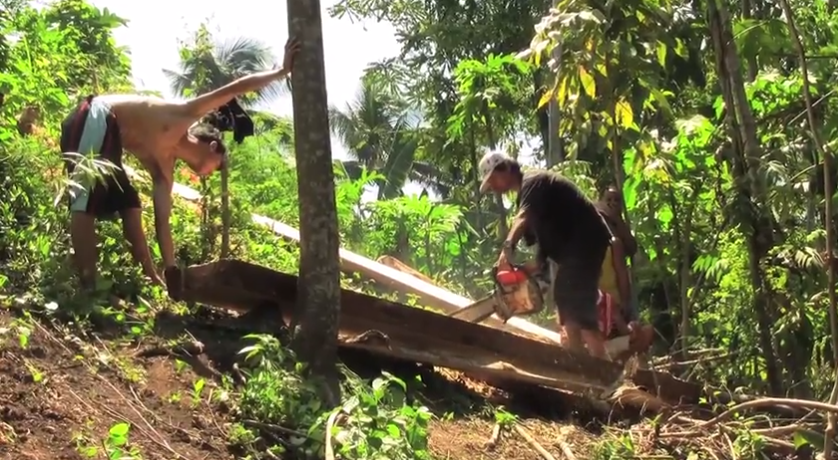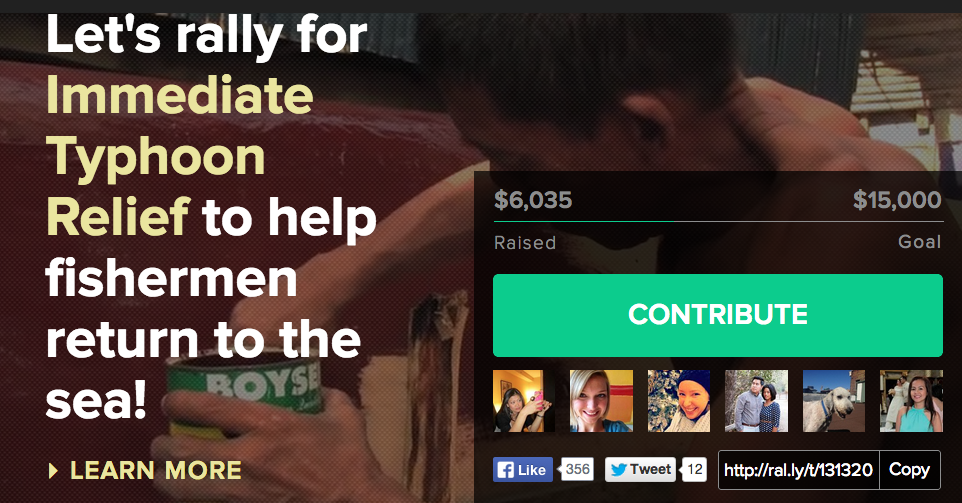Yolanda Journal: The Challenge of Getting Fishermen Back to the Sea
As the food, medicine, and shelter situation stabilizes (and it hasn’t stabilized yet) in the typhoon ravaged communities of Samar, Leyte, and the rest of the Visayas, the question of how to re-establish livelihoods destroyed by the storm is moving closer to the top of the list of concerns for those of us with displaced families in the affected areas. Fishing is a way of life in the coastal barangays that have been struck by the typhoon, and getting fishermen back to sea is a priority that can be addressed more directly than almost any other livelihood issue. The challenge is a simple one — repair or replace the boats and get the fishermen back out on the water.
For the past ten days Rena, Patrick, and I have been working on all cylinders to get a project going which will have as its goal getting the entire 28 boat fishing fleet of Guinob-an back out on the water within six months. We hope that if we are successful, we can expand the project to include other barangays along the coast of Eastern Samar. This post is intended to provide a status report on what we have learned, where we are in the process — and what sort of open issues and questions we have. It may be that someone will read our questions and help provide answers — we can think of no better outcome from writing the report.
The Native Way of Making A Fishing Boat
First, if you’re interested in seeing a fascinating short documentary that traces the steps in building a boat the native way in the Visayas, take five minutes and watch this video, which is excellent not just from a teaching point of view — but on other levels as well.
Following is a description of the steps, costs, and timeline of how a single boat is typically built, based upon the research we have done to date. (If you are an expert and can provide clarifications or insights — pls use the comment function as this is an ongoing process of refinement of our understanding.)
Obtaining the The Onayan (Hull) Days 1,2
The first step in the process is to go into the forest and find a suitable tree, and from that to harvest a piece suitable for making a hull. The hull is shaped roughly as a first step. Under the typical economic model, the person who gathers the hull also creates the legason (vertical ribs), the batayola (horizontal ribs), and the pamarong (prow) and sells all of this as a “kit” to the boatbuilder. The “going rate” for this it is P4,000. Because it is essentially a labor charge for the work involved in going into the forest, finding a tree, cutting it, and preparing the legason, batayola, and pamarong, it is possible to achieve a savings on this cost if volume production is undertaken. But for a one-off boat, you would typically pay P4,000 for someone to go into the forest and then deliver to you a hull, legason, batayola, and pamarong.
Assembling the Boat (Days 3,4)
The starting point for the typical boat builder is when he receives the Onayan kit, plus the following additional materials necessary for the creation of the boat:
The boat builder then first shapes the hull, creating a “dugout” form suitable to form the hull of the boat, and cuts rectangular notches into it where the legason (verticle ribs) will be inserted. He then inserts the vertical ribs and the pamarong (prow)
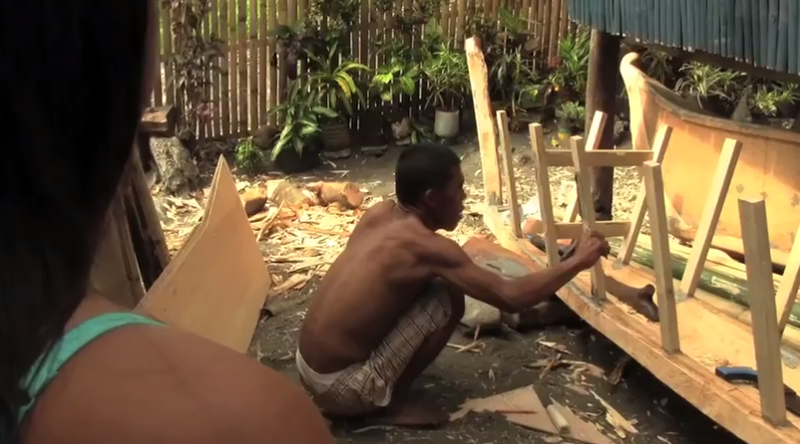
The boatbuilder adds the batayola (horizontal ribs) then attaches the 1/4 inch marine plywood, using bronze nails to fasten the plywood to the ribs and inserts it into the slot formed by the pamarong. A seat for the boatman is inserted (typially made of banboo)
Assembling and Installing the Motor (Day 5)
The motor typically consists of a number 5 engine purchased for P9,000, and the following prop/steering assembly:

The items are installed and tested.
Painting and Sealing the Boat (Day 6)
Epoxy and alcohol are used to seal the boat, and the hull is turned over for final shaping, sanding, and sealing. It is then painted.
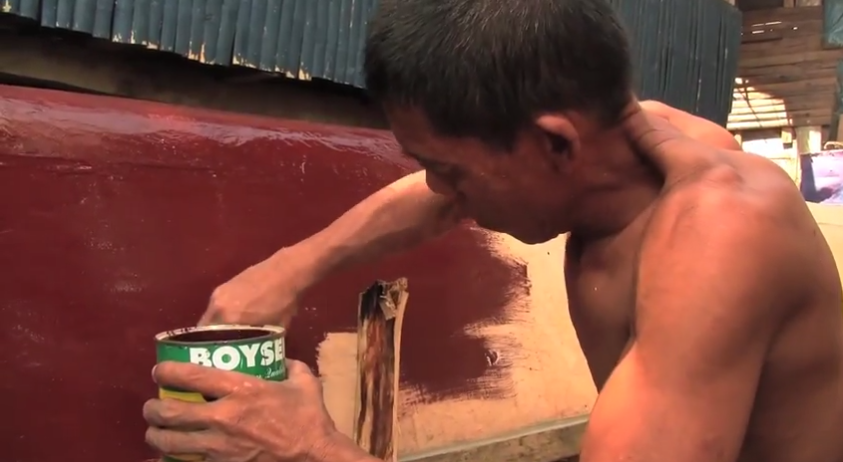
And so, in a week, a tree growing in the interior of the island becomes a boat on the water. It happens that quickly.
The total cost of materials today, in the aftermath of Yolanda, is approximately P20,000. Following is a full line item budget.
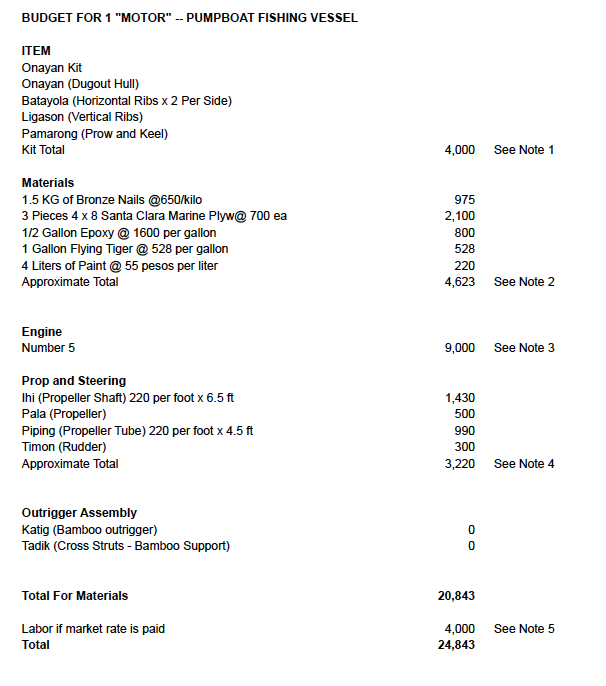
The foregoing budget comes out to a little less than $600 US, of which P16,000 are straight material costs, and 8,000++ are for the labor associated with procuring the hull, creating the legason, batayola, and pamarong, and then the labor for building the boat.
One of the philosophical questions that comes into play in the current sitaution is whether or not to pay full labor rates. On the one hand, it is possible to get heavily discounted labor, and savings in labor can be applied to the purchase of more materials — and more materials means more boats. On the other hand, better operational control is achieved through paying a fair wage, and money paid to the hull procurer and boat builder is money that gets spent in the community and helps fuel economic recovery. On balance, we feel that philosophically it is better to pay a rate that is close to the standard rate, until or unless such time as the operation is in full and continuous production, at which time a different payment model (salary pay rather than pay-for-the-job) can be implemented.
Program Timeline
We have enough resources at this point to order three boats as a start, and that is what we have done. Funds will be available in Catbalogan for pickup on December 10, and so we are looking to have three finished boats on the water before Christmas.
We will document the making of the boats and along the way learn what needs to be learned, and adjust any aspects of the operation that need to be adjusted. But our expectation is that before Christmas we will have “proof of concept” and at that point we will begin in earnest to solicit donations so that we can complete the replenishment of the fleet for Guinob-an, then move on to other coastal barangays. To replenish Guinob-an will cost approximately $20,000, to get all 28 fishermen back on the water.
We estimate that the total number of boats that have been destroyed in the three adjacent municipalities of Lawaan, Balangiga, and Giporlos is approximately 1,100.
Here is our project site.
Year of the Spy Book Trailer
Above is the Year of the Spy Book Trailer — for my upcoming non-fiction book about espionage upheavals on the streets of Moscow in 1985.
Below is a “trailer” showcasing the writing and video services I provide to clients.
Michael Sellers — Writing and Video Services
My eBook — Just released Dec 5, 2012
EBook You don't need a Kindle or iPad -- Download Adobe Digital Editions for Free, then read the .mobi (Kindle Format) or .epub (Nook, iPad Format) digital book on your computer. Or order the PDF which is formatted exactly like the print book.Recent Posts
- Arsha Sellers — Today I’m One Big Step Closer to Becoming a Real Forever Dad
- Meet Abby Sellers and Arshavin Sellers — My Wife, My Son, My Inspiration Every Day
- What the Mueller Report Actually Says
- Remembering James Blount, an American Who “Got” the Philippines in 1901
- America the Beautiful? You Mean America the Pitiful. I Am Ashamed

